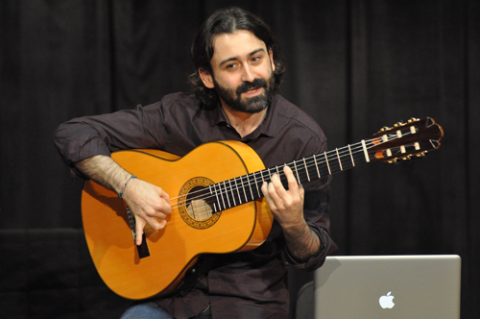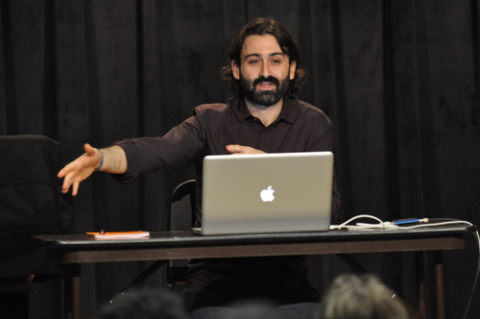Javier Limón Throws a Flamenco Party

Javier Limón
Photo by Phil Farnsworth

Limón demonstrated different strumming techniques.
Photo by Phil Farnsworth

Limón used his laptop to mix and match song clips.
Photo by Phil Farnsworth
Celebrated Latin musician and producer Javier Limón came to Berklee in March to give a series of clinics for Berklee students. The focus in his Flamenco Tools clinic, he told the assembled audience, was to teach them how to enjoy a flamenco party "without feeling like you're a National Geographic observer."
At a flamenco party, he explained, "100 people come play together without knowing what is going to happen." Yet they all know when to make their contribution, because they know the flamenco pattern and how to improvise within it.
To get there, he first went back to the basics of the form, which originated in his native Andalusia. He described the mingling of three cultures that created the style: Arabic, Jewish/Christian, and Gypsy. Later, at the beginning of the 19th century, Cuba became a major influence.
Limón handed students a sort of flamenco family tree, which described the main styles and their offshoots, explaining that there are 3,000–4,000 styles (or palos)—almost one for every village in Spain. He hit on a few of the main styles before coming to rest on bulería, which, he said, is the one everyone wants to learn when they start out.
- Fandangos: Characterized by more Jewish and Christian melodies, not very complicated rhythms (6/8 or 3/4).
- Tangos: A Latin American feel, with an African influence on the rhythm (4/4 or 12/8).
- Seguiriyas: Arabic, with the most difficult melodies (3/4 or 6/8, but it starts on the second part of 3/4).
- Cantes de Ida y Vuelta: From Latin America at the beginning of the century, the biggest influence of Cuban music.
- Soleares: A mix of rhythm from African cultures with harmonies from Jewish and Christian cultures. The lyrics are very important.
Bulerías are found in the soleares family, and are the favorite today. (According to Limón, almost 80% of today's flamenco records are soleares.) "The bulería is a way of life," Limón said. "When they sing that, everyone gets drunk and everyone gets happy." At flamenco parties, he explained, somebody starts a composition, and everybody follows him.
It starts with rhythm, or compás—actually, three different rhythms, said Limón. Over 3/4 you can feel 6/8 and 12/8, with the result of 1, 2, 3, 1, 2, 3, 1, 1, 1, 1, 2, 3. To illustrate, Limón pulled three students to the front, each clapping a different beat. Together, they made up the rhythm.
Over that rhythm, three kinds of compositions are mixed and matched, Limón explained, each 20–60 seconds long: the letra, or lyrics; the falseta, or guitarist's improvisation; and the baile, or dance, held together by the compás.
The next performer always comes in on the final 3 beat, whether it's with the guitar, lyrics, or the crowd shouting "Ole!" (a mutation of the word "Allah"). Limón warned that sometimes you have to "catch the singer," because the singer tries to trick the rest of the party by hurrying the beat, coming in on 2 rather than 3. As a result, it's in fashion now to come in between 2 and 3.
The compás pulls everything together, Limón said, but it is also the personality of the guitar player: every player's strumming (or rasgueo) technique is different. Here, Limón pulled out a guitar to show how different artists that he's worked with used different fingers to strum the strings.
Limón also pulled out his laptop to show how the different elements can be combined in many ways, leading to lots of flexibility within the structure. To do this, he pulled in clips from songs that he's produced, mixing and matching them onstage to create entirely different versions of the songs that nonetheless worked.
To familiarize themselves with the form, Limón recommended that students listen to music from some of the biggest flamenco stars, including singer, dancer, and actress Carmen Amaya and partners Camerón de la Isla and Paco de Lucía. "Sometime—in 100 years—we'll understand what this guy [de Lucia] has done to flamenco," said Limon, who has produced his records. "70 to 80% of flamenco today, ideas, charts, new instruments, are his. He's not just a guitar and a composer—he's the mind." De Lucia will receive an honorary doctorate at Berklee's Commencement in May.
In the end, Limón said he hoped that students could now understand what flamenco is and "why everyone but you knows what is happening."
